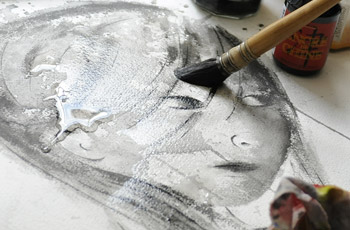What is a wash?
What are the "wet on wet" and "wet on dry" techniques?
When should you use them?
A quick tour of the major concepts you need to know before getting started.
What is a wash?
What are the "wet on wet" and "wet on dry" techniques?
When should you use them?
A quick tour of the major concepts you need to know before getting started.
The term wash covers all aspects of color: it is both what you thin down in water for a first coat and what dries on the paper.
There are three kinds of washes: solid block (a uniform area of color), graduated (which varies in intensity, from light to dark or from dark to light) and multicolored.
Before painting, check the strength of your wash by applying it to another sheet of paper. Once dry, it will be much lighter than when applied.
Watercolors painted onto a dry surface, that is, onto a blank sheet of paper or onto a previous dry wash (in which case, it is glazing). Once applied, the paint remains in place without running, and the contours, once dry, are very clear.
This technique is easy to master and a very useful way for you to render details precisely. To intensify a color, all you need to do is add a new wash on top of the previous one, once it is dry.
The watercolors are painted onto a wet surface, that is, onto a blank sheet of paper that has been soaked with water, or over a still wet coat of paint. Once applied, the color flows when it comes into contact with the wet surface.
What you need to know: the wetter the paper, the more the paint flows and disperses. Once dry, the edges are blurred and indistinct.
This technique is unpredictable and requires a bit of training. It will allow you to create very aesthetic immediate effects that work perfectly for painting skies and vegetation.
The difference tends to confuse beginners. A wash, plain and simply, is the application of a color to paper. Glazing, on the other hand, is the application of a wet layer of color over another, already dry, one.
By subscribing you will receive the Canson newsletter 6 times a year. This newsletter will contain information about products both new and old, we offer tutorials and we will also tell you our news (promotions, events, social media etc.). Please enter your contact information to complete your subscription.

